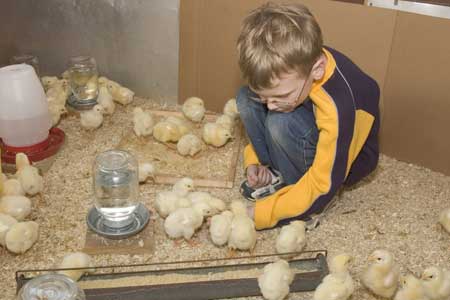
Chickens of differing ages have differing nutritional needs. Prepackaged poultry feed options therefore include rations for baby chicks, growing chicks, layers, and breeders. Which one is right for your chickens depends on their age and your purpose in raising them.
Starter Ration
Baby chicks should be fed a starter ration, which contains the high amount of protein they need for proper growth. If you’re raising chicks as layers, or for any purpose other than meat, continue feeding starter for the first 6 weeks, then transition to grower ration. If you are raising meat birds, transition them to grower ration when they reach 3 weeks of age.
Combination Starter/Grower
Some sources offer only a combination starter/grower ration. In that case, feed the combo ration to your layers and multipurpose chicks from day-old to 20 weeks of age. For meat birds, feed the combo ration from day 1 until slaughter.
Grower Ration
As birds grow, they gradually need less protein and more energy. Unless you’re feeding your multipurpose chicks a combination ration, transition from starter to grower ration at 6 weeks of age and continue to 18 weeks.
Feed meat birds a grower ration from age 3 weeks to slaughter. Fast growing broilers are usually ready to harvest at 6 to 8 weeks of age. Slower growing hybrids raised on pasture are typically ready at 11 weeks. Heritage breeds raised for meat take as long as 16 weeks.
Medicated Ration
Some chick rations contain a medication to control coccidiosis. Just enough drug is included to allow chicks to develop gradual immunity by the time they reach maturity. At that point they no longer need medication, so layer rations are not medicated.
Chicks raised in a proper environment shouldn’t need medicated ration. But a lot of chicken keepers use it, anyway, as a precautionary measure. The medication in the feed, amprolium, has no withdrawal period for meat birds.
Layer Ration
Starter and grower rations contain too much protein and too little calcium for chickens of laying age. On the other hand, layer rations contain too little protein and too much calcium for younger chickens. Therefore, do not transition layers or multipurpose birds to layer ration until they are at least 20 weeks of age.
Layer ration typically contains 16% to 17% protein. Once you settle on a specific ration, and your hens are laying well, stick with the same ration. Not all brands are exactly alike, and simply changing your brand can put a kink in egg production.
Breeder Ration
Some feed sources offer layer rations with different levels of protein. The higher protein levels are suitable for use during hot weather, when hens tend to eat less than usual. Otherwise they may obtain too few nutrients and stop laying.
Higher protein layer ration also improves the hatchability of eggs collected for incubation, so such feeds are sometimes called breeder rations. Not all feed sources offer a high protein layer ration. Your next best option is to use a turkey or gamebird ration containing 18% to 20% protein.
Turkey/Game Bird Ration
Turkey poults and game bird chicks grow faster than chickens. They therefore need more protein to keep up with their growth rate. A typical starter ration contains 28% to 30% protein, while a grower ration may range from 15% to 22% protein. Where a turkey or game bird ration is not available, you can boost the protein in a chicken ration by adding fish meal (about 65%), dried crickets (65%), or mealworms (50%).
Duck/Goose Ration
Similarly, you may have a hard time finding rations suitable specifically for ducklings and ducks, and an even harder time finding anything for goslings and geese. In that case you will likely end up feeding them rations designed for chickens.
Ducklings and goslings require more niacin — a type of vitamin B3 — to prevent leg deformities and lameness. Niacin may be provided by supplementing chick starter or grower ration with food-grade brewer’s yeast at the rate of 3½ cups per 10 pounds of feed until the birds start laying. Thereafter they no longer need a niacin supplement and will do fine on chicken layer ration.
Transitioning Rations
Most feed labels include a description of the species, age, and stage of the birds the ration is intended for. Read the label to be sure you are selecting the right ration for your specific flock.
Make any ration changes gradually. To avoid nutritional stress, begin by combining a little of the new ration into the old ration. Gradually increase the amount until the transition is complete.
And that’s today’s news from the Cackle Coop.
Gail Damerow is the author of Hatching and Brooding Your Own Chicks: Chickens, Turkeys, Ducks, Geese, Guinea Fowl.

